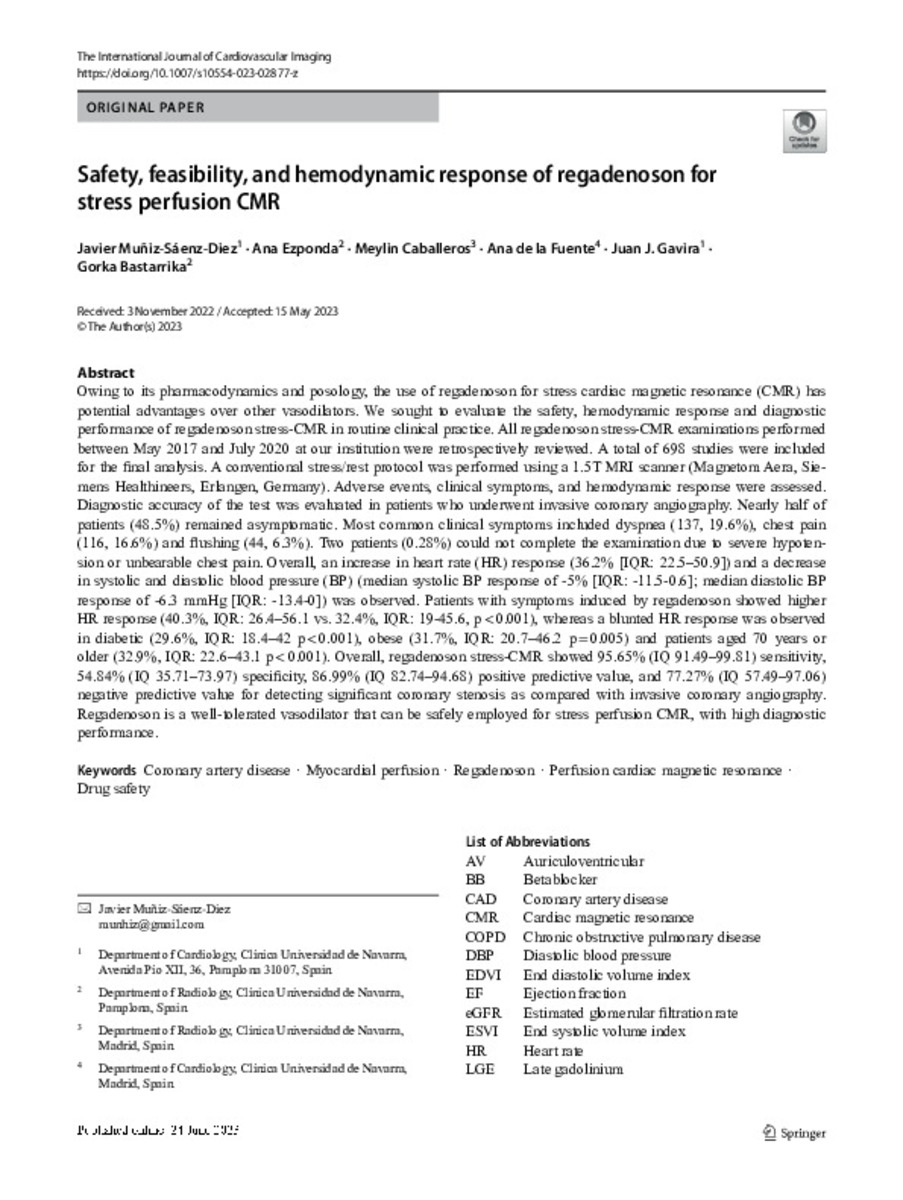Full metadata record
| DC Field | Value | Language |
|---|---|---|
| dc.creator | Muñiz-Sáenz-Diez, J. (Javier) | - |
| dc.creator | Ezponda, A. (Ana) | - |
| dc.creator | Caballeros, M. (Meylin) | - |
| dc.creator | Fuente, A. (Ana) de la | - |
| dc.creator | Gavira, J.J. (Juan José) | - |
| dc.creator | Bastarrika, G. (Gorka) | - |
| dc.date.accessioned | 2023-11-21T11:33:26Z | - |
| dc.date.available | 2023-11-21T11:33:26Z | - |
| dc.date.issued | 2023 | - |
| dc.identifier.citation | Muñiz-Sáenz-Diez, J. (Javier); Ezponda, A. (Ana); Caballeros, M. (Meylin); et al. "Safety, feasibility, and hemodynamic response of regadenoson for stress perfusion CMR". The International Journal of Cardiovascular Imaging. 39 (9), 2023, 1765 - 1774 | es_ES |
| dc.identifier.issn | 1875-8312 | - |
| dc.identifier.uri | https://hdl.handle.net/10171/67912 | - |
| dc.description.abstract | Owing to its pharmacodynamics and posology, the use of regadenoson for stress cardiac magnetic resonance (CMR) has potential advantages over other vasodilators. We sought to evaluate the safety, hemodynamic response and diagnostic performance of regadenoson stress-CMR in routine clinical practice. All regadenoson stress-CMR examinations performed between May 2017 and July 2020 at our institution were retrospectively reviewed. A total of 698 studies were included for the final analysis. A conventional stress/rest protocol was performed using a 1.5T MRI scanner (Magnetom Aera, Siemens Healthineers, Erlangen, Germany). Adverse events, clinical symptoms, and hemodynamic response were assessed. Diagnostic accuracy of the test was evaluated in patients who underwent invasive coronary angiography. Nearly half of patients (48.5%) remained asymptomatic. Most common clinical symptoms included dyspnea (137, 19.6%), chest pain (116, 16.6%) and flushing (44, 6.3%). Two patients (0.28%) could not complete the examination due to severe hypotension or unbearable chest pain. Overall, an increase in heart rate (HR) response (36.2% [IQR: 22.5–50.9]) and a decrease in systolic and diastolic blood pressure (BP) (median systolic BP response of -5% [IQR: -11.5-0.6]; median diastolic BP response of -6.3 mmHg [IQR: -13.4-0]) was observed. Patients with symptoms induced by regadenoson showed higher HR response (40.3%, IQR: 26.4–56.1 vs. 32.4%, IQR: 19-45.6, p<0.001), whereas a blunted HR response was observed in diabetic (29.6%, IQR: 18.4–42 p<0.001), obese (31.7%, IQR: 20.7–46.2 p=0.005) and patients aged 70 years or older (32.9%, IQR: 22.6–43.1 p<0.001). Overall, regadenoson stress-CMR showed 95.65% (IQ 91.49–99.81) sensitivity, 54.84% (IQ 35.71–73.97) specificity, 86.99% (IQ 82.74–94.68) positive predictive value, and 77.27% (IQ 57.49–97.06) negative predictive value for detecting significant coronary stenosis as compared with invasive coronary angiography. Regadenoson is a well-tolerated vasodilator that can be safely employed for stress perfusion CMR, with high diagnostic performance | es_ES |
| dc.description.sponsorship | Open Access funding provided thanks to the CRUE-CSIC agreement with Springer Nature. | es_ES |
| dc.language.iso | eng | es_ES |
| dc.publisher | Springer | es_ES |
| dc.rights | info:eu-repo/semantics/openAccess | es_ES |
| dc.subject | Coronary artery disease | es_ES |
| dc.subject | Myocardial perfusion | es_ES |
| dc.subject | Regadenoson | es_ES |
| dc.subject | Perfusion cardiac magnetic resonance | es_ES |
| dc.subject | Drug safety | es_ES |
| dc.title | Safety, feasibility, and hemodynamic response of regadenoson for stress perfusion CMR | es_ES |
| dc.type | info:eu-repo/semantics/article | es_ES |
| dc.description.note | This article is licensed under a Creative Commons Attribution 4.0 International License | es_ES |
| dc.identifier.doi | 10.1007/s10554-023-02877-z | - |
| dadun.citation.endingPage | 1774 | es_ES |
| dadun.citation.number | 9 | es_ES |
| dadun.citation.publicationName | The International Journal of Cardiovascular Imaging | es_ES |
| dadun.citation.startingPage | 1765 | es_ES |
| dadun.citation.volume | 39 | es_ES |
| dc.identifier.pmid | 37354385 | - |
Files in This Item:
Statistics and impact
Items in Dadun are protected by copyright, with all rights reserved, unless otherwise indicated.






